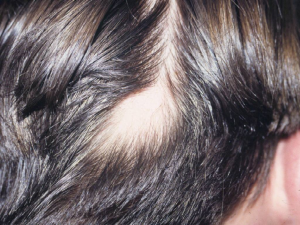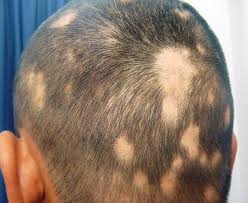In alopecia areata, the affected hair follicles are mistakenly attacked by a person’s own immune system (white blood cells), resulting in the arrest of the hair growth stage. Alopecia areata usually starts with one or more small, round, smooth bald patches on the scalp and can progress to total scalp hair loss (alopecia totalis) or complete body hair loss (alopecia universalis).
Alopecia areata occurs in males and females of all ages and races; however, onset most often begins in childhood and can be psychologically devastating. Although not life-threatening, alopecia areata is most certainly life-altering, and its sudden onset, recurrent episodes, and unpredictable course have a profound psychological impact on the lives of those disrupted by this disease
Some people develop only a few bare patches that regrow hair within a year. In others, extensive patchy hair loss occurs, and in a few, all scalp hair is lost (known as a alopecia totalis) or, hair is lost from the entire scalp and body ( known as alopecia Universalis). No matter how widespread the hair loss, the hair follicles remain alive and are ready to resume normal hair production whenever they receive the appropriate signal. In all cases, hair regrowth may occur even without treatment and even after many years.
Traction Alopecia is where the hair may temporarily or permanently stop growing in certain areas on the head. Traction Alopecia is usually caused by continuous and excessive stress on particular hairs, such as when hair is worn constantly in a bun or ponytail, or braids or cornrows. The hairs with the most tension may gradually stop growing resulting in hair loss. A change in hair style that reduces the traction on the hair is all that is needed to reverse the process, if caught early.
Androgenetic Alopecia is also known as Female Pattern Baldness, is the most common type of hair loss seen in women. The hair is genetically programmed to gradually fall out and occurs to 1 in 4 women. A woman will see hair loss happening over the top and frontal hairline and sometimes seen on sides as well. Although this condition tends to be more common post menopause, it does sometimes begin as early as puberty.
Scarring Alopecia – Occurs when scar tissue replaces destroyed normal tissue on the scalp and can be caused y any number of things such as burns, infectious agents or diseases such as Scleroderma, Lupus, Erythematosus. Because normal tissue is replaced, the hair cannot grow through scar tissue causing Scarring Alopecia to become permanent.
PHOTOS OF DIFFERENT TYPES OF ALOPECIA



